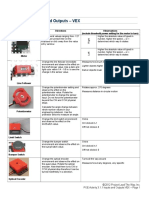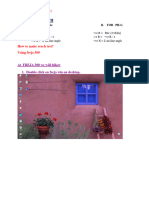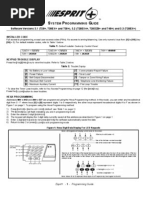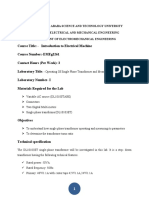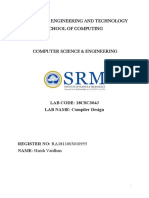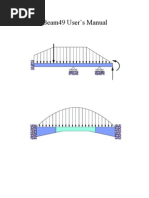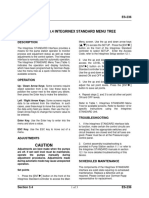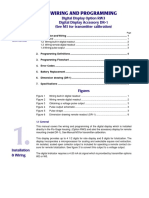100%(1)100% found this document useful (1 vote)
Hp-33S Survey and Cogo Program - Input /output Quick Instructions
Hp-33S Survey and Cogo Program - Input /output Quick Instructions
Uploaded by
Agustin AndonCopyright:
© All Rights Reserved
Available Formats
Download as PDF, TXT or read online from Scribd
Download as pdf or txt
Hp-33S Survey and Cogo Program - Input /output Quick Instructions
Hp-33S Survey and Cogo Program - Input /output Quick Instructions
Uploaded by
Agustin Andon100%(1)100% found this document useful (1 vote)
Original Title
HP33SCOGO Quick Instructions December 11 2009
Copyright
© © All Rights Reserved
Available Formats
PDF, TXT or read online from Scribd
Share this document
Did you find this document useful?
Is this content inappropriate?
Copyright:
© All Rights Reserved
Available Formats
Download as PDF, TXT or read online from Scribd
Download as pdf or txt
100%(1)100% found this document useful (1 vote)
Hp-33S Survey and Cogo Program - Input /output Quick Instructions
Hp-33S Survey and Cogo Program - Input /output Quick Instructions
Uploaded by
Agustin AndonCopyright:
© All Rights Reserved
Available Formats
Download as PDF, TXT or read online from Scribd
Download as pdf or txt
You are on page 1/ 6
HP-33S SURVEY and COGO PROGRAM - INPUT /OUTPUT QUICK INSTRUCTIONS
Copyright Melbard 2004 Revised 12/11/09
TASK INPUT PROCEDURES OUTPUT DISPLAY
Store coordinates for Point 1 Input the Northing Value of Point 1
Press ENTER
Input the Easting Value of Point 1
Press XEQ 1
Top number = N of Point 1
Bottom number = E of Point 1
Store coordinates for Point 2 Input the Northing Value of Point 2
Press ENTER
Input the Easting Value of Point 2
Press XEQ 2
Top number = N of Point 2
Bottom number = E of Point 2
INVERSE from Point 1 to Point 2 Store coordinates in XEQ 1 and XEQ 2
As outlined above then Press XEQ 3
Top number = Distance
Bottom Number = Azimuth (in D.MS)
SIDE-SHOT (from Point 1)
Create coordinates of a Side-Shot (SS) point
Store coordinates for point 1 in XEQ 1
Input the DISTANCE from Point 1
Press ENTER
Input the SS AZIMUTH direction (in D.MS)
Press XEQ E
To continue traversing from the SS point store it as Point 1 by
Pressing XEQ 1
Top number = N of SS Point
Bottom number = E of SS Point
BEARING-BEARING INTERSECTION (BB)
Create coordinates of a BB intersection point
Store coordinates in XEQ 1 and XEQ 2
Input the AZIMUTH direction (in D.MS) from Pt 1
Press ENTER
Input the AZIMUTH direction (in D.MS) from Pt 2
Press XEQ B
Top number = N of BB Point
Bottom number = E of BB Point
BEARING-DISTANCE INTERSECTION (BD)
Create coordinates of a BD intersection point
Store coordinates in XEQ 1 and XEQ 2
Input the AZIMUTH direction (in D.MS) from Pt 1
Press ENTER
Input the Distance from Pt 2
Press XEQ C
Press R/S for second possible solution
Top number = N of 1
st
BD Point
Bottom number = E of 1
st
BD Point
Top number = N of 2
nd
BD Point
Bottom number = E of 2
nd
BD Point
DISTANCE-DISTANCE INTERSECTION (DD)
Create coordinates of a DD intersection point
Store coordinates in XEQ 1 and XEQ 2
Input the DISTANCE from Pt 1, then Press ENTER
Input the DISTANCE from Pt 2, then Press XEQ D
Press + if solution is Right of line 1 to 2 or
Press if solution is Left of line1 to 2
Then Press R/S
Top number = N of DD Point
Bottom number = E of DD Point
1
Copyright Melbard 2004 Revised 12/11/09
TASK INPUT PROCEDURES OUTPUT DISPLAY
View Coordinates Stored in Point 1 and Point 2
SWAP coordinates (the 2
nd
R/S will activate this
function, otherwise the swap will not take place)
Press XEQ Z to view coordinates of Point 1
Press R/S to view coordinates of Point 2 (optional)
Press R/S to swap Point 1 and Point 2 (optional)
Top number = N of Point 1
Bottom number = E of Point 1
Top number = N of Point 2
Bottom number = E of Point 2
Top number = N of Point 1
Bottom number = E of Point 1
Area by Coordinates
(this program can only handle a maximum 7 sided
polygon. Split a larger polygon into parts and sum
the parts for the total area)
Input the Northing of the first polygon point, then Press ENTER
Input the Easting of the first polygon point, then Press XEQ A
Input the Northing of the 2
nd
polygon point, then Press ENTER
Input the Easting of the 2
nd
polygon point, thenPress R/S
Continue in a similar fashion entering N and E of each point
consecutively around the polygon always pressing R/S
Important: End the boundary by re entering the N and E of the
first polygon point and then Press R/S
All values shown in the display are
meaningless until the last R/S is pressed
after closing on the first point
Top number = Area in SF
Bottom number = Area in Acres
INTEPOLATION (and EXTRAPOLATION)
Store data range upper limit values in keys 7 and 8
With STO 7 and STO 8
Store data range lower limit values in keys 1 and 2
With STO 1 and STO 2
Store intermediate value in key 4 with STO 4
Press XEQ 5 for the solution
Note the key layout below:
STO 7 STO 8
STO 4 XEQ 5
STO 1 STO 2
Both the
Top number and Bottom Numbers = Answer
2
Copyright Melbard 2004 Revised 12/11/09
TASK INPUT PROCEDURES OUTPUT DISPLAY
Vertical Curve Program
(Solves for Stations and Elevations of a
vertical curve based on the increment
distance desired, like stations, 50 or
stations, 25)
Input the following data by storing them in the specified storage
registers.
PVI Sta. value STO A (omit the + sign when entering stations)
PVI Elevation STO B
Grade 1 STO C
Grade 2 STO D
VC Length STO E
Station Increment for output STO F (example, use 50 if sta.)
Press XEQ V
R/S (answer based on the station increment you entered)
R/S (keep pressing R/S to see each station on the VC)
|
|
|
V
R/S (eventually the PVT of the VC will be displayed)
R/S (if you hit too many R/Ss and go past the PVT
the program will display meaningless numbers)
Top number = Station of PVC
Bottom number = Elevation of PVC
Top number = Station of next point on VC
Bottom number = Elevation of this Station
Top number = Station of next point on VC
Bottom number = Elevation of this Station
|
|
V
Top number = Station of PVT
Bottom number = Elevation of PVT
If NOEXISTENT is displayed with one to may
R/S keys hit after the PVT, then press C to
return back to normal display mode)
Vertical Curve Solution (for High or Low Point)
First store all VC data in the above format and
Run the above Vertical Curve Program
(you do not need to press the R/Ss if incremental points are not
needed)
Press XEQ H
Top number = Sta. of High or Low Point
Bottom number = Elev. Of High or Low Point
Vertical Curve Solution (for Any Point)
First store all VC data in the above format and
Run the above Vertical Curve Program
(you do not need to press the R/Ss if incremental points are not
needed)
Input the Staton of the VC point desired
Press ENTER
Press XEQ P
Top number = Sta. of the Specified Point
Bottom number = Elev. of the Specified Point
3
Copyright Melbard 2004 Revised 12/11/09
TASK INPUT PROCEDURES OUTPUT DISPLAY
Horizontal Curve Solutions
When the Central Angle and Radius are known
Input the Central Angle in D.MS
Press ENTER
Input the Radius
Press XEQ J
R/S Not all R/S keys need to be pressed if you
do not need the following curve data
R/S
R/S
R/S
Top number = Central Angle
Bottom number = Radius
Top number = Arc Length
Bottom number = Tangent Length
Top number = Chord
Bottom number = Degree of Curvature (Arc)
Top number = External Distance
Bottom number = Mid Ordinate
Top number = Sector Area (SF)
Bottom number = Arc to Chord Area (SF)
Horizontal Curve Solutions
When the Central Angle and Arc Length are
known
Input the Central Angle in D.MS
Press ENTER
Input the Arc Length
Press XEQ K
R/S as above between answer sets
All answers in the same order as above.
Horizontal Curve Solutions
When the Radius and Arc Length are known
Input the Radius
Press ENTER
Input the Arc Length
Press XEQ L
R/S as above between answer sets
All answers in the same order as above.
4
Copyright Melbard 2004 Revised 12/11/09
TASK INPUT PROCEDURES OUTPUT DISPLAY
Station and Offset Solution
Store the coordinates of two points on the station line in
XEQ 1 and XEQ 2 (the point stored in XEQ 1 is where the
station distance is measured from)
Input the Northing of the offset point
Press ENTER
Input the Easting of the offset point
Press XEQ F
Top number = Distance along Line 1-2
in feet from Point 1
Negative distances are in
the back direction from
Point 1
Bottom number = Offset Distance
perpendicular to
Line 1-2
Positive offsets are RT of
centerline and Negative
offsets are LT of
centerline
Stake out a Point
Store the coordinates of the two points on the backsight line in
XEQ 1 and XEQ 2 (the point stored in XEQ 1 is where the
instrument would be for stake out, also this is where the
distance is measured from to the stake out point. The point
stored in XEQ 2 is the backsight point, this is where you would
zero out the instrument before turning the angle)
Input the Northing of the stake out point
Press ENTER
Input the Easting of the stake out point
Press XEQ I
Top number = Distance from instrument
(Point 1) to stake out point
Bottom number = Angle right (or CW angle)
from the backsight
Point 2 to the stakeout
point
5
Copyright Melbard 2004 Revised 12/11/09
TASK INPUT PROCEDURES OUTPUT DISPLAY
SIDE-SHOT (from Point 1)
With an angle and a distance
Create coordinates of a Side-Shot (SS) point
Traverse to the newly created point and backsight
to the previous point 1. Then repeat the above
process to create a new point. The process of
traversing (or moving up) and creating new points
can be repeated over and over.
Store the coordinates of the two points on the backsight line in
XEQ 1 and XEQ 2 (the point stored in XEQ 1 is where the
instrument is setup, also this is where the distance is measured
from to the side shot point. The point stored in XEQ 2 is the
backsight point, this is where you would zero out the instrument
before turning the angle to the side shot or foresight point)
Input the DISTANCE from Point 1to the Sideshot Point
Press ENTER
Input the ANGLE (in D.MS)
Press XEQ O (letter O not zero)
Press R/S
(for the newly created point to become point 1 and for the
previous point 1 to now become point 2)
Top number = N of SS Point
Bottom number = E of SS Point
Top number = N of SS Point
Bottom number = E of SS Point
6
You might also like
- Operating Manual: Power / Phase Angle / Power Factor TransducerNo ratings yetOperating Manual: Power / Phase Angle / Power Factor Transducer80 pages
- Axe 4 Digital (One-Alarm) & 6 Digital Totalizer Counter (72X72Mm)No ratings yetAxe 4 Digital (One-Alarm) & 6 Digital Totalizer Counter (72X72Mm)2 pages
- Ystem Rogramming Uide: Software Versions 3.1 (728+, 738EX+ and 738+), 3.2 (728EX4+, 728DZ8+ and 748+) and 3.3 (728EX+)No ratings yetYstem Rogramming Uide: Software Versions 3.1 (728+, 738EX+ and 738+), 3.2 (728EX4+, 728DZ8+ and 748+) and 3.3 (728EX+)20 pages
- Unit 2 IO and Memory Interfacing - cs3691No ratings yetUnit 2 IO and Memory Interfacing - cs369172 pages
- System Programming Guide: Software Versions 5.0 (728ULT) and 5.0 (738ULT)No ratings yetSystem Programming Guide: Software Versions 5.0 (728ULT) and 5.0 (738ULT)20 pages
- PDF Procedures in Using Ge Survey Systempdf DDNo ratings yetPDF Procedures in Using Ge Survey Systempdf DD21 pages
- 752BD/CXU Blu-Ray Disc Player RS-232 Control ProtocolNo ratings yet752BD/CXU Blu-Ray Disc Player RS-232 Control Protocol14 pages
- Operating Instructions Rish CON V With DisplayNo ratings yetOperating Instructions Rish CON V With Display68 pages
- Operating Instructions Rish CON TPT 96 X 96No ratings yetOperating Instructions Rish CON TPT 96 X 9659 pages
- Pulse/Analog Input Flow Rate/Totalizer/Batch Controller (Two-Stage) Meter MRT-B SeriesNo ratings yetPulse/Analog Input Flow Rate/Totalizer/Batch Controller (Two-Stage) Meter MRT-B Series8 pages
- Return To List of Lessons: Calculator Lesson 25 Basic Vector OperationsNo ratings yetReturn To List of Lessons: Calculator Lesson 25 Basic Vector Operations2 pages
- Operating Manual Eine+ DC DPM 48x96 Rev GNo ratings yetOperating Manual Eine+ DC DPM 48x96 Rev G26 pages
- Honeywell Dc1000 Dc1010 Dc1030 Dc1040 Manual50% (2)Honeywell Dc1000 Dc1010 Dc1030 Dc1040 Manual29 pages
- Payroll Schemas and Personnel Calculation Rules (PCR'S) : Skip To End of Metadata Go To Start of MetadataNo ratings yetPayroll Schemas and Personnel Calculation Rules (PCR'S) : Skip To End of Metadata Go To Start of Metadata22 pages
- Survey Practical No. 9 Total Station SurveyNo ratings yetSurvey Practical No. 9 Total Station Survey11 pages
- General-Catalog_Technical-Reference Introduction to SEL LanguageNo ratings yetGeneral-Catalog_Technical-Reference Introduction to SEL Language4 pages
- X y X y R: Calculation of Circle Centre-Point and Radius From Three Points On Circle CircumferenceNo ratings yetX y X y R: Calculation of Circle Centre-Point and Radius From Three Points On Circle Circumference2 pages
- HP33S Survey Solutions With COGO Code December 11 2009 Rev2!9!11No ratings yetHP33S Survey Solutions With COGO Code December 11 2009 Rev2!9!119 pages
- Arduino & Iot Monitoring Baby System - SignedNo ratings yetArduino & Iot Monitoring Baby System - Signed10 pages
- Akronex Ul Clean-Agent Extinguishing System UnitsNo ratings yetAkronex Ul Clean-Agent Extinguishing System Units5 pages
- 03-Base Station Reparenting From BSC6900 To BSC6910 of A Different R Version100% (1)03-Base Station Reparenting From BSC6900 To BSC6910 of A Different R Version27 pages
- Irlz44Z Irlz44Zs Irlz44Zl: Automotive MosfetNo ratings yetIrlz44Z Irlz44Zs Irlz44Zl: Automotive Mosfet13 pages
- Effect of Technology in Academic PerformanceNo ratings yetEffect of Technology in Academic Performance4 pages
- CHIRANJIT-DAS-11900123170-Analog and Digital ElectronicsNo ratings yetCHIRANJIT-DAS-11900123170-Analog and Digital Electronics11 pages
- A Virtual Coordinate-Based Bypassing VoidNo ratings yetA Virtual Coordinate-Based Bypassing Void7 pages
- 2009 - Extrusion of 7075 Aluminium Alloy Through Double-Pocket Dies To Manufacture A Complex ProfileNo ratings yet2009 - Extrusion of 7075 Aluminium Alloy Through Double-Pocket Dies To Manufacture A Complex Profile10 pages
- 2.1 Data Representation On Cpu: SUMMARY: This Topic Introduces The Numbering Systems: Decimal, Binary, OctalNo ratings yet2.1 Data Representation On Cpu: SUMMARY: This Topic Introduces The Numbering Systems: Decimal, Binary, Octal101 pages
- Operating Manual: Power / Phase Angle / Power Factor TransducerOperating Manual: Power / Phase Angle / Power Factor Transducer
- Axe 4 Digital (One-Alarm) & 6 Digital Totalizer Counter (72X72Mm)Axe 4 Digital (One-Alarm) & 6 Digital Totalizer Counter (72X72Mm)
- Ystem Rogramming Uide: Software Versions 3.1 (728+, 738EX+ and 738+), 3.2 (728EX4+, 728DZ8+ and 748+) and 3.3 (728EX+)Ystem Rogramming Uide: Software Versions 3.1 (728+, 738EX+ and 738+), 3.2 (728EX4+, 728DZ8+ and 748+) and 3.3 (728EX+)
- System Programming Guide: Software Versions 5.0 (728ULT) and 5.0 (738ULT)System Programming Guide: Software Versions 5.0 (728ULT) and 5.0 (738ULT)
- 752BD/CXU Blu-Ray Disc Player RS-232 Control Protocol752BD/CXU Blu-Ray Disc Player RS-232 Control Protocol
- Pulse/Analog Input Flow Rate/Totalizer/Batch Controller (Two-Stage) Meter MRT-B SeriesPulse/Analog Input Flow Rate/Totalizer/Batch Controller (Two-Stage) Meter MRT-B Series
- Return To List of Lessons: Calculator Lesson 25 Basic Vector OperationsReturn To List of Lessons: Calculator Lesson 25 Basic Vector Operations
- Payroll Schemas and Personnel Calculation Rules (PCR'S) : Skip To End of Metadata Go To Start of MetadataPayroll Schemas and Personnel Calculation Rules (PCR'S) : Skip To End of Metadata Go To Start of Metadata
- General-Catalog_Technical-Reference Introduction to SEL LanguageGeneral-Catalog_Technical-Reference Introduction to SEL Language
- Ti 84 Plus Calculator: QuickStudy Laminated Reference GuideFrom EverandTi 84 Plus Calculator: QuickStudy Laminated Reference Guide
- AutoCAD 2010 Tutorial Series: Draw and Modify ToolsFrom EverandAutoCAD 2010 Tutorial Series: Draw and Modify Tools
- Computer Numerical Control Programming BasicsFrom EverandComputer Numerical Control Programming Basics
- X y X y R: Calculation of Circle Centre-Point and Radius From Three Points On Circle CircumferenceX y X y R: Calculation of Circle Centre-Point and Radius From Three Points On Circle Circumference
- HP33S Survey Solutions With COGO Code December 11 2009 Rev2!9!11HP33S Survey Solutions With COGO Code December 11 2009 Rev2!9!11
- 03-Base Station Reparenting From BSC6900 To BSC6910 of A Different R Version03-Base Station Reparenting From BSC6900 To BSC6910 of A Different R Version
- CHIRANJIT-DAS-11900123170-Analog and Digital ElectronicsCHIRANJIT-DAS-11900123170-Analog and Digital Electronics
- 2009 - Extrusion of 7075 Aluminium Alloy Through Double-Pocket Dies To Manufacture A Complex Profile2009 - Extrusion of 7075 Aluminium Alloy Through Double-Pocket Dies To Manufacture A Complex Profile
- 2.1 Data Representation On Cpu: SUMMARY: This Topic Introduces The Numbering Systems: Decimal, Binary, Octal2.1 Data Representation On Cpu: SUMMARY: This Topic Introduces The Numbering Systems: Decimal, Binary, Octal



